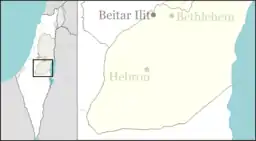Kfar Etzion
Kfar Etzion (Hebrew: כְּפַר עֶצְיוֹן, lit. Etzion Village) is an Israeli settlement organized as a religious kibbutz located in the Judean Hills between Jerusalem and Hebron in the southern West Bank, established in 1927, depopulated in 1948 and re-established in 1967. It is located 4.7 km east of the Green Line and falls under the jurisdiction of Gush Etzion Regional Council.[2][3] In 2019, Kfar Etzion had a population of 1,156.
Kfar Etzion
כְּפַר עֶצְיוֹן | |
|---|---|
 | |
 Kfar Etzion | |
| Coordinates: 31°38′56.4″N 35°6′55.44″E | |
| District | Judea and Samaria Area |
| Council | Gush Etzion |
| Region | West Bank |
| Affiliation | Religious Kibbutz Movement |
| Founded | 1927 (original) 1934, 1943, 1967 (re-establishments) |
| Founded by | Yemenite immigrants |
| Population (2019)[1] | 1,156 |
| Website | k-etzion.co.il |
The majority of the international community considers Israeli settlements in the West Bank illegal under international law, but the Israeli and the American governments dispute this.[4]
History
Migdal Eder
In January 1927, the Zikhron David society, a group of 160 Orthodox Jews from the Mea Shearim neighborhood of Jerusalem, established a small farming community, "Migdal Eder," on land south of Jerusalem.[5] The name was taken from a verse in the Bible, Genesis 35:21, which referenced a tower by the same name. During the 1929 Palestine riots, Migdal Eder was attacked and destroyed. Residents of the neighboring Palestinian village of Beit Ummar sheltered the farmers, but they could not return to their land.[6]
Old Kfar Etzion
In the early 1930s, the land was purchased by Haredi businessman Shmuel Zvi Holtzman from Rehovot,[7] who renamed the settlement "Kfar Etzion," a play on his own name: Yiddish “holts” and German "Holz" means “wood”, which translates to “etz” in Hebrew). The Jews were forced to leave again in the wake of the 1936–39 Arab revolt. Much of what Holtzman and his comrades had built was demolished by the Arabs.[6]
In 1943–47, the kibbutz movement sent out groups of settlers to establish four kibbutzim, creating what became known as the Etzion bloc. Kfar Etzion, Ein Tzurim, Massu'ot Yitzhak and Revadim were destroyed in the 1948 Arab-Israeli War, and the entire area came under Jordanian rule.[6]
The kibbutzim held off the attacks for ten days until Kfar Etzion fell. In the Kfar Etzion massacre on 14 May, 157 Jewish inhabitants of the village were murdered, as all but four of the inhabitants were executed by Arab Legion and irregular forces. The other three kibbutzim surrendered. The inhabitants there were taken as prisoners of war and released nine months later.[8]
 Kfar Etzion water tank, 1943
Kfar Etzion water tank, 1943 Kfar Etzion (Kefir 'Etsyon) 1945, 1:250,000
Kfar Etzion (Kefir 'Etsyon) 1945, 1:250,000 Kfar Etzion 1945
Kfar Etzion 1945 Neve Ovadia library exterior 1946
Neve Ovadia library exterior 1946 Kfar Neve Ovadia reading hall
Kfar Neve Ovadia reading hall Kfar Etzion 1946
Kfar Etzion 1946 Kfar Etzion 1947
Kfar Etzion 1947 Kfar Etzion, 1947
Kfar Etzion, 1947 Kfar Etzion 1948
Kfar Etzion 1948
New Kfar Etzion settlement
In 1967 Israel occupied the West Bank in the Six-Day War. The Israeli cabinet decided to re-establish the settlement of Kfar Etzion despite receiving legal advice that establishing such settlements in occupied territory would be illegal under the Fourth Geneva Convention.[9] A key figure identified with Kfar Etzion's reestablishment after 1967 is Hanan Porat, who lived on the kibbutz as a child prior to its destruction in 1948.[10][11]
Another figure involved in Kfar Etzion's resettlement is Elyashiv Knohl, a rabbi of the community whose father fought in the 1948 Arab–Israeli War and was captured during the war by the Jordanians. According to Knohl, Kfar Etzion's original settlers were socialists, and members of the kibbutz continue to channel their incomes to a joint account.[2] Today Kfar Etzion houses a museum and archive documenting the history of Gush Etzion.
In the 2013 Middle East cold snap a meter of snow fell on the Kfar Etzion area.
Economy
Residents of Kfar Etzion earn their livelihood growing cherries, flowers, olives, almonds, and grapes. Some raise chickens, and others work in Jerusalem. As of 2012 there is a large clothing store on the settlement. In 2012 the price of a 120-square-meter home on the settlement was ILS1.1 million while the price of a 200-square-meter home was ILS1.8 million.[2]
See also
References
- "Population in the Localities 2019" (XLS). Israel Central Bureau of Statistics. Retrieved 16 August 2020.
- Yahav, Nir; Breiner, Yehoshua (12 June 2012). נוהל שכן: בין העיירה בית אומר להתנחלות כפר עציון. Walla! News (in Hebrew). Retrieved 8 September 2012.
- "Gush Etzion". Gush Etzion. Archived from the original on 5 September 2011. Retrieved 24 August 2011.
- "The Geneva Convention". BBC News. 10 December 2009. Retrieved 27 November 2010.
- Jerusalem and its environs: quarters, neighborhoods, villages, 1800–1948, Ruth Kark, Michal Oren-Nordheim
- Settlements in Focus: Gush Etzion Archived 28 June 2016 at the Wayback Machine
- "Collection of Documents – Establishing Kfar Etzion – Shmuel Zvi Holtzman". Archived from the original on 21 October 2017. Retrieved 16 February 2020.
- Moshe Dayan, 'The Story of My Life'. ISBN 0-688-03076-9. Page 130. Describes negotiations with Abdulla el-Tel about the release of 670 Israelis in the "Jordan POW camp at Mafrak." He states that 320 of them were from the Etzion bloc, including 85 women.
- Donald Macintyre, Secret memo shows Israel knew Six Day War was illegal. Independent, 26 May 2007. (on web.archive)
- Bronner, Ethan (4 October 2011). "Hanan Porat, Jewish Settlement Leader, Dies at 67". The New York Times. Retrieved 8 September 2012.
- Lis, Jonathan; Levinson, Chaim (5 October 2011). "Hanan Porat, 1943 – 2011 / Pioneer of settler movement". Haaretz. Retrieved 8 September 2012.
Further reading
- Between Jerusalem and Hebron: Jewish Settlement in the Pre-State Period, Yossi Katz
External links
- Official website (in Hebrew)
- Peace Now fact sheet
